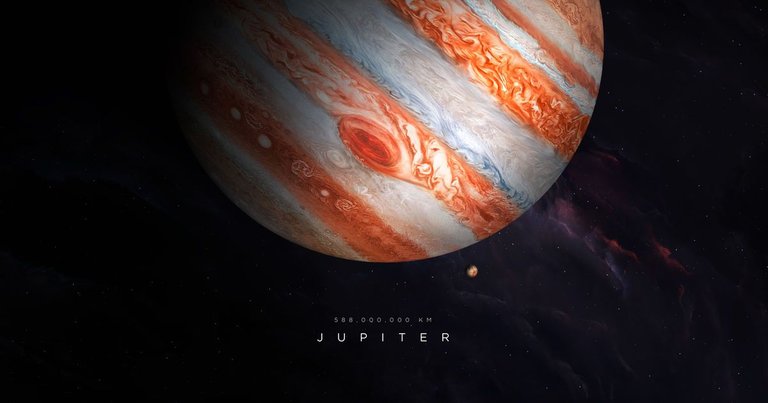He is the planet of superlatives, hugely big and super heavy and lives up to his name. Not withut reason he was given the name of the father of the gods: Jupiter.
With a diameter of 143,000 kilometers, Jupiter is not only the largest planet in our solar system, it also weighs 2.47 times as much as all other planets put together. The actual reason for the enormous difference in weight is that Jupiter consists of much denser gases. Now you ask yourself how gas can be so heavy at all? Gas also has a weight and a lot of gas is very heavy, especially when it is compressed. And just this amount of gas nearly made Jupiter to a star. Of course there is already one star in our solar system, our sun, that's clear but there almost was a second star, Jupiter.
A star is in principle only a very large accumulation of gases, or better said hydrogen. If you ever want to build a star, you just have to squeeze a lot of hydrogen together and then the stellar fusion process starts. Jupiter consists of 90 percent hydrogen and that's quite a lot, but to become a star it needed a little more mass. He would have to be 88 times heavier than now to start the fusion process.
As the fifth planet, Jupiter orbits the sun in an approximately circular orbit between 4.95 and 5.46 astronomical units. This happens in 11 years, 315 days and 3 hours, of course according to our Earth scales. Its rotation of 9 hours and about 50 minutes around its own axis makes him to the fastest rotating planet in our solar system.
Jupiter own 79 moons and it is quite possible that more will be discovered in the future. The four largest Jupiter moons are the so-called Galilean moons which were already described in 1610 by the Italian astronomer Galileo Galilei. These Galilean moons are called Io, Europa, Ganymede and Kallisto, but also the other 65 moons are extremely interesting and one suspects on some even water to occur. But many do not know is that Jupiter also has a very weak ring system.
Jupiter is a gas planet whose entire surface is full of giant Tornados and Cyclones. The largest of these storms is the so-called big red spot. The earth would fit into this huge anti-cyclone twice. However, scientists observe that the big red spot has been shrinking for several years. It is assumed that this is due to the interaction with other storms.
Jupiter, the father of all planets, is also often seen as a failed stellar system.






A mysterious planet for sure
Jupiter is Zeus’s name in Roman mythology and it’s not only a comparison. Jupiter’s magnet fields defends the great part of Solar System from meteorites.
thats right @anforo, the outer planets are like a shield :)
Saludos @oendertuerk sin dudas hace honor a su nombre, excelente forma de enfocar el tema, te sigo…
Gracias @shaotech
Hello @Oendertuerk one of the things that strikes me the most is the number of moons that it has...
Those moons could have been planets if Jupiter wasn't so massive he pulls them into his orbit.
Hola @leynedayana, it may well be possible that in the near future we will even detect more moons.
Hi, @oendertuerk!
You just got a 1.39% upvote from SteemPlus!
To get higher upvotes, earn more SteemPlus Points (SPP). On your Steemit wallet, check your SPP balance and click on "How to earn SPP?" to find out all the ways to earn.
If you're not using SteemPlus yet, please check our last posts in here to see the many ways in which SteemPlus can improve your Steem experience on Steemit and Busy.